I met Bea in 2019, over Wiener Schnitzel in Islington, London. She was living there at the time, and since then I believe she has moved over 10 times – every time we speak, she is working in a new city. We met in person then, but I came across her work in 2018, at a show curated by Eugenio Re Rebaudengo at the Italian Embassy in London. A massive collage carpet was taking over a room flooded with daylight, and I immediately fell in love with her work. Soon after, it was acquired and delivered to Palazzo Monti, installed in our main room, where it still sits and became one of our most recognizable and appreciated pieces of the collection. Then in 2021 she came to Palazzo Monti for a residency, and it was during that month we spent together that I really got the know the person behind the art, adding incredible human value to artworks that I was already in love with.
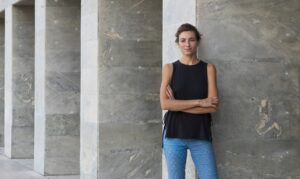
Bea Bonafini, photo credits Amedeo Benestante
Edoardo Monti: Ciao Bea! How is Barcelona treating you? I can see that you haven’t stopped a moment since we last met, and you managed to move again to another city. Let’s get into it. Could you share some details on your experience at Villa Lena, back in 2016?
Bea Bonafini: Ciao Edo – great to hear from you! My time at Villa Lena felt like an incubator. A bubble filled with exciting people, a bit detached from the ‘real world’. My favourite moments were walking to the studio via an olive grove, discovering abandoned homes of the neighbouring ghost village, and organising collaborative and performative dinners with the other resident artists.
Wow, sounds like a dream. I’d love to visit sometime soon. During the residency, did you work on new works, somehow inspired by the people, light and architecture around you?
It was a hiatus from my usual practice. I played with textiles I found in Prato, to make a series of textile works that later I destroyed. The studio became strewn with totemic stacked sculptures from the wood workshop’s offcuts. And I developed really delicate pencil drawings that reflected the intricacy of floor inlays and grotesque decorative elements, drawn from both the Villa itself, and the churches and cathedrals in nearby towns.
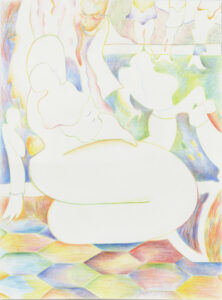
Bea Bonafini, “Untitled”, 2016, Caran D’Ache pencil on Sienese cotton paper, courtesy of Villa Lena Foundation
What were the key elements that you appreciated while your time at Villa Lena? What did you take away with you?
I loved working in the countryside, without feeling isolated. It was a protected gap of time free of responsibilities. With that peace of mind I could tune into new strands of research and take risks.
We all love lists. Can you share your best memories from the time, perhaps some about experience with fellow artists in residency and with the team at Villa Lena?
For sure! A bunch of things we did together: stairwell guitar concerts; giant polenta feasts; creepy halloween parties; photography experiments in the forest; satanic cove discoveries; staging cannibal dinners for music videos; driving the residency car into an olive tree; learning ceramics for the first time; getting pasta factory tours and emerging wearing their yellow uniforms. We were a pretty good batch.
Sounds like you had a lot of fun. I wish I could have know you by then, to see how your practice evolved during the residency and changed from before to after the experience. Generally, for those who are not familiar with your works, how would you describe your artistic style and how has it evolved over the course of your career?
I see my art practice as one of excavation. Often I find myself digging for new approaches to making work. It’s a process of discovering which form speaks to who I am in that moment of my life. And playing with materials as though I’m manipulating them for the first time. I think this approach has evolved to protect a curiosity for the unknown, and strengthen its flexibility so as to adapt to my changing needs.
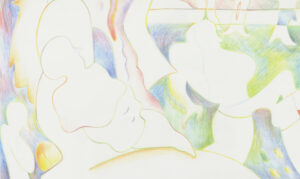
Bea Bonafini, “Untitled”, 2016, dettaglio, Caran D’Ache pencil on Sienese cotton paper, courtesy of Villa Lena Foundation
What themes or concepts inspire your artwork and why do they resonate with you?
I feel very close to the mystical, the personal, and esoteric narratives. I’m fascinated by what moves people to connect with irrational concepts or the stories they tell themselves to not feel alone in this world. The myths and tales we’ve conjured to transport us to other realities. Or the rituals we’ve developed to mark big life transitions. I want my work to express interconnectedness, like the connecting pieces of a collage and the collision of symbols, ideas and cultural references.
I am obsessed with production, living myself in an artist residency and being involved in every aspect of the technical production steps. Can you talk about your creative process, from initial idea to finished piece?
Although it’s terrifying, I have a cyclical urge to deconstruct the way I make work. During this phase I make lots of quick drawings and surround myself with them. I scatter prints of images I’m drawn to all over the studio floor. I’ll experiment with scraps of material I’ve never worked with before, to see if they surprise me. It’s kind of butterfly-like. I’ll skip from one end of the room to the other, flirting with different stuff until I get sucked into something. Then I’ll dive into the deep end. I upscale the idea and process and just go for it. I try not to overthink it. Working on simultaneous works takes the pressure off the single work, and helps the body of work come to life collectively.
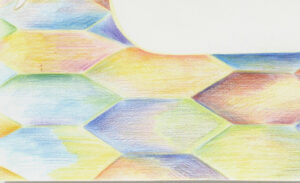
Bea Bonafini, “Untitled”, 2016, dettaglio, Caran D’Ache pencil on Sienese cotton paper, courtesy of Villa Lena Foundation
Back to 2016, and the piece you donated to Villa Lena’s collection. What inspired you to create Untitled?
The work belongs to a series of pencil drawings which responded to cultural references of the territory, the quality of the light, and some details of the historic Villa. This drawing’s populated by faceless, anonymous bodies donning medieval outfits, standing around like small comical figurines. The figure taking center stage is a mother and child, seated in a sort of meditation pose, and they’re much larger than any other figure. The floor tiles were those of my bedroom. I just allowed all the religious and medieval iconography I kept seeing in my site visits in that area to float into my drawing the way they wanted to.
Let’s wrap it with some more in-depth discussion about your creative process. How do you use technology and new media in your art and how has this influenced your creative expression?
A inherited an iPad a few years ago. Now I use it often to sketch out ideas, plan out shows, and make technical drawings for tapestry productions or print work. Recently I combined a watercolour piece with digital painting for a large-scale double-sided printed piece for the Gubbio Biennial in Italy. It sometimes helps to lift the pressure off, I can try something out digitally and minimize material waste.
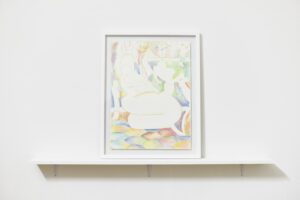
Bea Bonafini, “Untitled”, 2016, Caran D’Ache pencil on Sienese cotton paper, courtesy of Villa Lena Foundation
What challenges and opportunities do you see in the world of contemporary art, particularly in today’s digital age?
We’re living in such unpredictable times. The stress of this precarity means that artists have an even bigger role to play in offering moments of peace and magic, elevating us from a state of anxiety, and offering truths about connectedness. The technological challenge could be to learn to use AI as a tool, and to enter the immaterial realm in an intelligent way that doesn’t disconnect us from our environment and other beings.
How do you balance the tension between tradition and innovation in your art?
I’m aware that I can’t be original, but I can strive to be authentic. I indirectly collaborate with makers and thinkers of the past every day, that’s the tradition I carry within me while I make. I see innovation as the authenticity I can offer to express my unique perspective.
Very last question! In your opinion, what is the most important message or emotion you hope to convey to your audience through your art?
I would love for the viewer to feel spiritual exuberance while experiencing my work, and to feel somehow elevated.
Thank you Bea, it has been a pleasure chatting with you. Hope to see you very soon, perhaps in Villa Lena for a throwback experience!
Edoardo Monti
Info:
Villa Lena
via comunale di Toiano 42, 56036 Palaia PI
VillaLena.org

is a contemporary art magazine since 1980






NO COMMENT